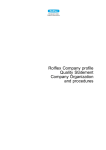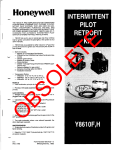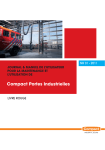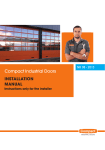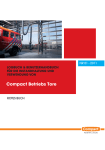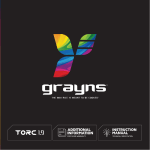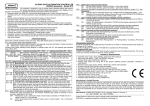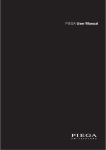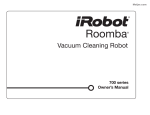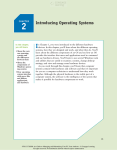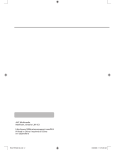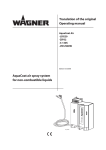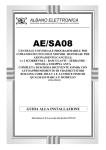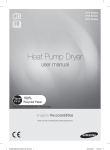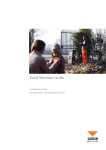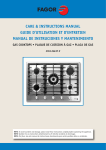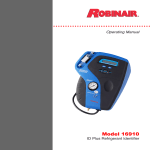Download Click a catergory to show available files
Transcript
NR 01 - 2011 LOGBOOK & USER MANUAL FOR MAINTENANCE AND USE OF THE Compact Industrial Doors RED BOOK All rights reserved: Reprinting, copying, processing, re-issuing and publication in any form or on any medium is forbidden without the written permission of Rolflex Nederland BV. Rolflex Nederland BV is not liable for any possible adverse consequences of printing errors, confusion or deficienties in this manual. Subject to alterations. Sous réserves de modification. Änderungen vorbehalten. Wijzigingen voorbehouden. 2 OPERATING MANUAL Contents page 1. Definitions 4 2. Safety guidelines 4 3. Warnings and symbols used 5 4. Use for the intended purpose 6 5. Safety devices for the Compact door 7 6. General safety instructions 8 7. Operating the door 10 8. Emergency device/manual operation function 12 9. Inspection and technical maintenance 13 10. Cleaning 15 11. Troubleshooting 16 12. Environmental conditions 16 13. Removal 17 14. EC declaration of conformity 18 15. Inspection and Maintenance Checklist 19 16. Logbook 22 17. Doorspecific data 23 3 First of all we would like to congratulate you on your purchase of the Compact industrial door. Rolflex has developed the Compact industrial door in cooperation with the Innovatie Centrum, architects and many end-users. There is no need for extensive construction work prior to installation. The unique guided system guarantees a long lifespan with minimal maintenance. The Compact industrial door fits in anywhere and you get the benefits! Use of this manual: This operating manual is intended to help you use your Rolflex Compact industrial door safely. We expect the owner to take responsibility for the proper functioning and use of the Compact door. This manual should help you to do this. 1. DEFINITIONS: Qualified independent installer: competent person or an organisation offering door installation services to third parties, including upgrading. Competent person: person who has been suitably trained in order to gain the knowledge and practical experience required and provided with the necessary instruc-tions to enable the required installation to be carried out correctly and safely. Owner: natural or legal person who has the power of disposal of the door and takes responsibility for its operation and use. 2. SAFETY GUIDELINES The manufacturer is not liable for damage or injury caused by failure to follow this manual and the safety guidelines. Always pay attention to the safety guidelines. 3. 4 3. WARNINGS AND SYMBOLS USED The meaning of these symbols is explained in the text next to the symbols. The symbols in the text therefore refer to the explanations in the text. WARNING SIGNS AND SYMBOLS: Attention: General hazard symbol. Warning: extra care required! Indicates a hazard that can result in physical injury or death. Attention: Suspended loads and falling loads. Care required when lifting heavy loads. Never lift heavy items by muscle power alone. Consult the applicable national and/or international regulations. Walking or standing underneath the item(s) may lead to physical injury or death. Attention: Warning: Risk of trapping or collision Indicates a hazard that can result in physical injury or death. Attention: Double-checking required! Check: Incorrect use may result in a device not working properly or may give rise to a safety hazard. Attention: See separate manual See separate product catalog for controls or for additional electrical components. 5 4. USE FOR THE INTENDED PURPOSE This door is designed for industrial use only and is equipped with safety devices. You should check in advance whether the applicable national and international regulations permit industrial use of these doors in the country where they are to be used. The Compact door opens and closes vertically. The door is designed for the automatic opening and closure of a doorway and should only be used for this purpose. Constant use is not permitted. The Compact door is suitable for indoor and outdoor use. The Compact door is operated by means of a motor that is supplied with it. The method of operation will depend on the motor used and the weight of the door. The motors for Compact doors are designed for use in dry areas. For use in non-dry areas the Compact door must be equipped with additional fittings. Read the operating manual for the motor carefully before commissioning. Suitable weather conditions for use of the door The door is suitable for use within a normal temperature range (See chapter 12). It may be dangerous to use the door in strong winds. 6 5. SAFETY DEVICES FOR THE COMPACT DOOR The Compact door has been designed with the utmost care and attention. Your safety as user is central in this and is ensured by the use of high-quality parts and materials. The doors are also equipped with a number of standard safety devices which exceed current European safety standards. It is important to carry out an annual general inspection of the door and this inspection should also include checking the safety devices to see that they are operating properly and reliably. Fall safety device: The Compact door is equipped with a fall safety device. If a cable breaks, the fall safety device will prevent the door from falling. If this safety device is triggered, the door will be held fast by safety catches in the tracks. After the safety device has been triggered, the door must be checked by a qualified independent installer before it can be used again. Always contact your supplier if the fall safety device has been triggered. Cable slack safety device This switch will be triggered if the steel cables go slack. If this safety device is triggered, the electrical circuit will be disconnected automatically so that the door can no longer be operated electrically. The door must be checked by a qualified independent installer before it can be used again. Contact your supplier Anti-lifting safety device The Compact door is equipped with an anti-lifting safety device as standard. If an attempt is made to lift up the door from outside, the hooks in the base units will fasten tight in the tracks preventing the door from being lifted up any further. This protective safety device can delay or prevent any break-in attempt. The functioning of the hooks should be checked regularly. If the anti-lifting safety device has been triggered, we recommend that you contact your supplier. 7 6. GENERAL SAFETY INSTRUCTIONS Safety guidelines You should check in advance on the national and international safety instructions that should be complied with during use of this Compact door. General safety instructions s )FSAFETYDEVICESARETRIGGEREDORFAULTSARISEAQUALIlEDINDEPENDENT installer should be contacted immediately to carry out inspection and/or repairs. s 4HESCOPEOFAPPLICATIONOFTHE#OMPACTDOORISSPECIlEDIN%. For an explanation of the complete standard, see www.rolflex.com\downloads\en13241-1.pdf (English). s $URINGINSTALLATIONMAINTENANCEREPAIRCOMMISSIONINGANDREMOVAL care should be taken with regard to potential hazards as stipulated in the standards EN12604 and EN12635. This work should always be carried out by a qualified independent installer. s -AKESURETHATNOONEINPARTICULARCHILDRENANDNOITEMSAREWITHINTHE range of movement of the Compact door. Keep the range of movement and the operating area of the Compact door clear at all times. s .EVERLIFTITEMSANDORPEOPLEBYMEANSOFTHE#OMPACTDOOR s )TISDANGEROUSTOWALKORRUNUNDERNEATHACLOSINGDOOR s $ONOTCHANGEORREMOVEANYPARTS4HISCOULDDISABLEIMPORTANTSAFETY s 0ROTECTTHEDOORAGAINSTAGGRESSIVEANDCAUSTICAGENTSEGSUBSTANCES devices. Only use original parts. released by nitrite reactions in stones or mortar, or against acids, alkalis, salt and grit or paints or sealants with an aggressive effect. s %NSURETHATTHEREISSUFlCIENTDRAINAGEANDVENTILATIONDEHUMIDIlCATION underneath the guide tracks and the Compact door. s 5SEOFTHEDOORINHIGHWINDSMAYCAUSEARISKOFSERIOUSINJURYANDDAMAGE Installation by a qualified independent installer The Compact door should only be installed, inspected, maintained and repaired by a qualified independent installer. None of this work should be carried out by anyone other than a qualified independent installer. As well as this operating manual, the Compact door comes with a separate installation manual 8 which is exclusively intended for the qualified independent installer. Installation of the various parts should be carried out according to the installation manual. After installation and inspection of the installation, the Compact door may be put into use. WARNING! Risk of injury and damage from door movement, especially if unexpected The Compact door closes downwards and may trap people and/or items. Placing items against or near to the door may cause damage and injury if the movement of the door causes them to fall over. s !LWAYSMAKESURETHATTHEREARENOITEMSORPEOPLEINPARTICULARCHILDREN within the range of movement of the Compact door during operation. Keep the range of movement of the door clear at all times. WARNING! Fall path of the door It is dangerous to place items against the door or the tracks or to fasten anything to them. Never stay underneath the door for longer than necessary and do not place any items in the doorway or directly beneath the door. WARNING! What to do if there is a power failure If there is a power failure, always switch off the controls and motor (turn off the power). For an explanation and how to operate the emergency manual operating system, see Section 8 of this booklet. 9 7. OPERATING THE DOOR The door should only be operated by personnel who have been properly trained and who have read this manual carefully. This operating manual should always be stored beneath the control box. WARNING! Risk of injury from incorrect operation! Incorrect operation may cause people and/or items to become trapped. Only open and close the door using the operating controls/pulse generators supplied (controlled, steady movement). When opening and closing the Compact door, make sure that its range of movement is free of obstacles. WARNING! Risk of injury or damage from improper use Never use the Compact door to lift or otherwise move people and/or items. Never walk underneath a moving door, regardless of whether it is opening or closing. DOOR FUNCTION WITHOUT OBSTRUCTION SAFETY DEVICE Without obstruction safeguard: (dead man’s switch) 1 - up: door will rise until open 2 - stop: door movement will be stopped 3 - down: door will lower. This button has to be held down. If this button is released, the door will stop immediately. Before you start to operate the door, make sure that the tracks and the doorway are clear of obstacles and people. A. If the door is not in use, it should be kept closed. B. The door will open as shown in the diagram on the left. Movement is stopped by operating button 2 or will stop when the door is fully open. C. To close the door, follow the diagram on the left. Make sure that there is nothing underneath the door. D. The door stops closing as soon as the ‘down’ button 3 is released. 10 DOOR FUNCTION WITH OBSTRUCTION SAFETY DEVICE 1 - up: door will rise until open 2 - stop: door movement will be stopped 3 - down: door will lower until closed Before you start to operate the door, make sure that the tracks and the doorway are clear of obstacles and people A. If the door is not in use, it should be kept closed. B. The door will open as shown in the diagram below. Movement is stopped by operating button 2 or will stop when the door is fully open. C. To close the door, follow the diagram below. Make sure that there is nothing underneath the door. D. The door will stop because the obstruction safety device has been triggered. 11 8. EMERGENCY DEVICE/MANUAL OPERATION FUNCTION If the motor is supplied without an emergency hand chain: Take the handle of the motor and insert it underneath the motor. Open or close the door by rotating the handle. To end manual operation with the handle, remove the handle from the motor and reattach it in the proper place on the motor if manual operation is no longer required. Optional: If the motor is supplied with an emergency hand chain: Pull on the green lever. This triggers the operation of the emergency hand chain. Move the door by pulling on the chain. Pull on the red lever to switch off the operation of the emergency hand chain and turn the motor on again if manual operation is no longer required. 12 9. INSPECTION AND TECHNICAL MAINTENANCE Have the Compact door inspected and serviced by a qualified independent installer at least once a year. If there are more than 2500 door cycles (a door cycle is one opening and closing of a door) per year, we recommend an inspection every six months. Safety guidelines Safety guidelines You should check in advance on the national safety regulations that should be complied with during the inspection, maintenance and/or repair of the Compact door. Always observe the applicable national safety regulations. Always have inspections, maintenance and repairs carried out by a qualified independent installer. Warning! Risk of physical injury from moving door Door movements, especially if unexpected, present a risk of physical injury during inspection, maintenance and repair work. Always switch off the motor and controls before carrying out an inspection of the Compact door in order to prevent the Compact door from opening or closing unexpectedly or the operating mechanism from being triggered while work is being carried out! Wear safety glasses and safety gloves, and where necessary other PPE such as a helmet, ear protectors and/or a safety vest. The Compact door closes downwards and may trap people and/or items. Placing items against or near to the door may cause damage and injury if the movement of the door causes them to fall over. Make sure that there are no items or people, in particular children, within the range of movement of the Compact door during operation. Keep the range of movement of the door clear at all times. Do not use the door in strong winds! 13 Warning! Risk of injury from faulty safety devices Improper use or inadequate inspection and maintenance may lead to important safety devices failing or being faulty. Be alert during inspections to the possibility that safety functions might have failed. INSPECTION AND TECHNICAL MAINTENANCE Check condition of the Compact door: s #HECKTHATTHEMOTORCONTROLSARESWITCHEDOFF s #HECKTHE#OMPACTDOORANDITSFUNCTIONINGUSINGTHE)NSPECTIONAND Maintenance Checklist on page 22 ff. s !FTERCARRYINGOUTANINSPECTIONMAINTENANCEANDORREPAIRSALWAYS complete the log book. The construction of the Compact door is state of the art. Pressure points and wear, in particular of the top guide track, are normal for the construction and cannot be avoided. They do not justify complaints to the supplier or manufacturer. During inspection, special attention should be paid to pressure points and wear, in particular of the top guide track. Replace damaged parts. The rollers should rotate easily when the door is shut. Always check whether all the rollers are correctly tightened . Clean the tracks if necessary but do not grease them! 14 10. CLEANING Risk of injury and damage! There is a risk of injury and/or damage when cleaning the Compact door or parts if the door mechanism is triggered. Always switch off the motor and controls (disconnect the power) before cleaning the Compact door in order to prevent the Compact door from opening or closing unexpectedly or the operating mechanism from being triggered while work is being carried out! N.B.: Use of harsh cleaning equipment or the wrong cleaning agents can cause scratches on the window frames or other parts of the Compact door. Clean cold water without any cleaning agents is usually adequate for cleaning the Compact door. For more stubborn marks, warm water with a pH-neutral, non-abrasive cleaning agent (domestic washing-up liquid, pH value 7) can be used. To ensure the Compact door continues to function safely, dirt must be prevented from getting into the guides. If dirt does get into the guides, it should always be removed by means of a suitable method and without using aggressive cleaning agents. A wide range of environmental conditions (e.g. maritime climate, acids, salt grit, air pollution, paint damage) can make additional painting or more frequent cleaning necessary. Compact door panel + Window frames Clean the surface of the door with clean water, a soft clean cloth and a neutral, non-abrasive cleaning agent. Make sure that no water gets into the motor and the electrical parts during cleaning. Do not use any aggressive cleaning agents, such as glass cleaners or abrasive cleaners, or coarse/sharp items to remove dirt. After cleaning, rinse the door with running water. Rating plate and label Clean the rating plate and label in the same way as the Compact door. It must be clearly legible at all times. 15 11. TROUBLESHOOTING Warning! Risk of injury and damage from uncontrolled door movements Faults may cause uncontrolled door movements (stiff running, collision damage or other faults) which lead to injury or damage to items. If there are any uncontrolled door movements, always switch off the motor and controls! If there are any uncontrolled door movements, contact a qualified independent installer immediately. If the installer cannot repair the fault, contact the manufacturer of the Compact door and/or the motor. If the fall safety device is triggered, always contact a qualified independent installer and get them to carry out a full inspection. 12 ENVIRONMENTAL CONDITIONS N.B.: Damage from temperature variations Variations in indoor and outdoor temperatures can cause buckling of the door elements (bi-metal effect). If the door is operated at this time, there is a risk of permanent damage. The door is only suitable for use in the following conditions: Temperature: Outside - 40 °C to + 55 °C Inside - 20 °C to + 55 °C Relative humidity: 20% to 90% Use of the door in strong winds may cause a hazard. As a precaution, do not use the door in strong winds. 16 13. REMOVAL Safety guidelines There is a risk of physical injury during inspection, maintenance, repair and removal work. Always observe the applicable national safety regulations. Removal should only be carried out by a qualified independent installer. Risk of physical injury Wear safety glasses and safety gloves, and where necessary other PPE such as a helmet, ear protectors and/or a safety vest. Ensure that the door is closed. Then always switch off the motor and controls! Removal should be carried out according to this installation manual by carrying out the installation sequence in reverse. 17 14. EC Declaration of Conformity (according to the requirements in the Machinery Directives) In the Declaration of Conformity, the manufacturer declares that the product complies with the essential requirements of European Directive 1999/5/EC. The manufacturer: Rolflex Nederland BV Nijverheidsweg 23 7081 AE Ulft Netherlands Phone: 0031 (0)315 695959 Fax: 0031 (0)315 695950 Email rolflex@rolflex.com Internet: www.rolflex.com declares on its own responsibility that the product: COMPACT INDUSTRIAL DOOR to which this declaration refers, is in complete agreement with the Machinery Directives: Directive 2006/42/EC dated 29-12-2009 replaces Directive 98/37/EC (98/79/EC) which replaces Directive 89/392/EEC) and in agreement with the following EEC regulations: Low tension Directive 2006/95 EEC replaces 73/23/EEC (93/68/EEC) EMC Directive 2004/108/EEC replaces 89/336/EEC (92/31/EEC, 93/68/EEC) and that SP, the Swedish National Testing and Research Institute, as Notified Body no. 0402 (announced authority), has carried out initial type-testing, which can be used to support the EC declaration of conformity according to the requirements as stated in the harmonized NORM SS-EN 13241-1 : 2003 Testing by SP was carried out according to the following standards: EN 12604:2000 Doors – Mechanical aspects (requirements) EN 12605:2000 Doors – Mechanical aspects (method of testing) EN 12453:2000 Safety for use of the electrically operated doors (requirements) EN 12445:2000 Safety for use of the electrically operated doors (method of testing) It is not permitted to use the complete machine in which our product is installed before the declaration of conformity with the machinery directives has been handed over. It is not permitted to use the complete machine in which our product is installed before the declaration of conformity with the machinery directives has been handed over. Rolflex Nederland BV Ulft, January 2010 J.H. Megens, director Without the written permission of Rolflex Nederland BV, any adjustment or modification to the doors is for your own risk and responsibility and the Declaration of Conformity will be invalid. 18 15. INSPECTION AND MAINTENANCE CHECKLIST This section is only applicable for qualified independent installers! Work safely – protect yourself and your surroundings. Make sure that the door cannot be operated accidentally: remove the plug from the wall socket. Uninstall the rail security devices so that you can carry out a proper inspection. Non-motor side Check the following (action where required): 1. Damage, bending, correct attachment to the floor. Rails Clean if external conditions cause dirt to get into the tracks. 2. Bearing rollers Correct attachment, wear and tear 3. Top and drop arms Correct attachment, wear and tear 4. End caps Correct attachment, wear and tear 5. Folding panels Damage, bending, correct attachment to the floor. 6. Box rods Damage, bending, correct attachment to the floor. 7. Return pulleys Bearings, smooth running, damage to pulleys, attachment points 8. Cable Check for loose wires or fraying, cracks, cuts, fluff formation, rupture, kinks or twists and the attachment points at the drum and on the underside of the foot plates. 9. Top rubber Check for damage and for correct sealing of the lintel beam. Motor side Check the following (action where required): 10. Rails Damage, bending, correct attachment to the floor. 11. Bearing rollers Correct attachment, wear and tear 12. Top and drop arms Correct attachment, wear and tear 13. End caps Correct attachment, wear and tear 14. Folding panels Damage, bending, correct attachment to the floor. 15. Box rods Damage, bending, correct attachment to the floor. 16. Return pulleys Bearings, smooth running, damage to pulleys, attachment points 19 17. Cable Check for loose wires or fraying, cracks, cuts, fluff formation, rupture, kinks or twists and the attachment points at the drum and on the underside of the foot plates. 18. Drum 19. Shaft 20. Motor Correct attachment of the bearing plates, the attachment of the spline to the shaft, the splineshaft. Check for crack formation Attachment points, spline attachment to the shaft. Check for correct functioning and correct end contact settings. Check all electrical accessories, e.g. the slack cable switch. 21. Spreader rod Bending, attachment to the floor 22. Top rubber Check for damage and for correct sealing of the lintel beam. Electrical components Check the following (action where required): 23. Flood protection Check for correct working 24. Cabling Check all cables for damage 25. Electrical Check working and for damage accessories Door leaf Check the following (action where required): 26. Check smooth working of drop mechanism, lifting/break-in Foot brackets protection damage, attachment points to panel, cable attachment, working. * Apply an oil film to the entire unit before rust starts to form. 27. Door leaf Attachment of hinges and parkers between panels. 28. Panels Damage: 29. 30. 31. Lower rubber Panel sealing Side seals 32. Wicket door (optional) Check correct sealing at floor, damage Attachment and damage Check attachment, wear and tear (replace after 15,000 cycles) Check functioning of wicket door fastenings and safety switch. * Adjust door leaf until level 20 General: 33. Obstacles Remove all external obstacles in the vicinity of the door. * Warn the user(s) that possible obstacles, e.g. pallets, brooms, etc., can damage the door and its users or even result in a hazardous situation. 34. Rust formation Rust formation can impede the movement of the door; apply a film of oil where necessary to prevent further rusting. * If the door has been installed in an aggressive environment, warn the user(s) if the door has not been protected sufficiently against such operating conditions. This can cause damage to the door and its users and can even result in a hazardous situation. In such cases, it is recommended that maintenance is carried out 2 x per year or as often as is required. 35. Cleaning Clean the panels on the inside and outside with running water. Be especially careful with the glazing: Do not use glass cleaning agents (as these contain aggressive substances). Never use scouring agents, scrapers, sharp objects, etc.! If necessary, clean by using warm water and a small quantity of a mild detergent suitable for plastics and rinse off afterwards with running water. 36. Warnings If you detect irregularities on the Compact door which might jeopardize the safety of the user, you must immediately bring this to the attention of the owner of the Compact door. When you have done so, if the door cannot be directly repaired by you, block the door to prevent further use. The installer or supplier of your door can then make a suitable offer for repairing the door and making it safe for operation once more. 37. Winding up Remove the red maintenance book from the folder hanging inside the door control cabinet and make a note on the back if you have carried out maintenance on the door and any repairs you have carried out. After completion of all maintenance works, attach the date sticker for the next maintenance session to the type plate of the door indicating to the user when the next maintenance session needs to be carried out. 21 16. LOG BOOK (for technical details, see inside cover of this manual) Rolflex Nederland B.V. Nijverheidsweg 23 7081 AE ULFT NETHERLANDS +31 (0)315 - 695959 Installation company/installer: 1. Name: 2. Address: 3. Country: 4. Tel. no.: 5. Location of door (if more than one): Date and result of the inspection and operational test before commissioning: Date: ________________ Result of inspection and operational test: OK/NOT OK 6. Date of installation: 7. Date of commissioning: 8. Installer’s signature: Date of inspection: Faults, repairs and adjustments: 22 Name + Installer’s signature Nijverheidsweg 23 NL-7081 AE Ulft Netherlands Tel. + 31 (0)315 69 59 59 Fax + 31 (0)315 69 59 50 E-mail *C5.200.EN*

























